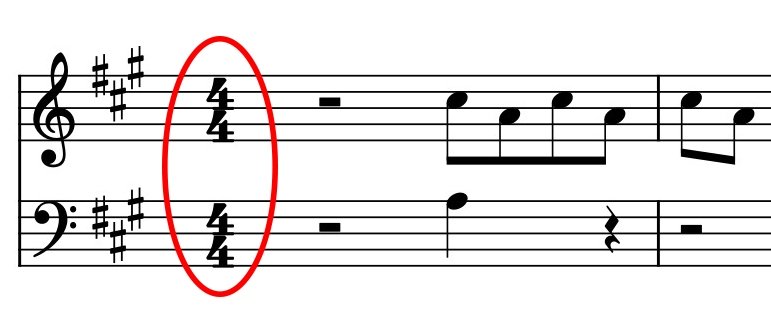What is a time signature?
A time signature, also known as a meter signature, is a symbol that appears at the beginning of a piece of sheet music to indicate the rhythm of the song.
The following image shows the time signature (in a red circle) written on both the treble and bass clefs at the start of sheet music.

It tells you how to organize the notes and how to count the beats.
It’s like a roadmap for rhythm, helping you understand the pulse and feel of the song.
Two Stacked Numbers
A time signature consists of two numbers written in the form of a fraction, which means two numbers stacked on top of each other.
Here’s what the two numbers written one above the other represent:
Top Number (Numerator)
What does the top number in a time signature represent?
The top number indicates how many beats there are in each measure, which is a section of musical notation with vertical lines. Think of it as the number of “units” in each group.
For example, in a 4/4 time signature, the top number is 4, indicating there are four beats in each measure.
Bottom Number (Denominator)
What does the bottom number in a time signature represent?
This number represents the type of note that forms one beat. In a 4/4 time signature, the bottom number is 4, indicating that the quarter note gets one beat. In a 3/4 time signature, the quarter note still gets one beat, but there are three beats in each measure.
Time signatures can change throughout a piece of music to create different rhythmic effects.
Here are some common time signatures and their meanings:
- 4/4: The most common time signature, it has four quarter note beats per measure. Think of marching music or pop songs.
- 3/4: Three quarter note beats per measure, often used in waltzes and lullabies.
- 2/2: Two half note beats per measure, creating a slow and stately feel.
- 6/8: Six eighth note beats per measure, often used in jigs and country music.
Time signatures can be more complex than these, but understanding the basics will help you navigate most music. They tell you not only how many beats to count but also the emphasis or stress on each beat. This influences the overall rhythm and groove of the piece.
For example, 4/4 time has a strong emphasis on the first beat of each measure, giving it a steady, square feel. In 3/4 time, the emphasis is often on the first and third beats, creating a waltz-like swing.
Importance of Time Signature
Why is it important for musicians to know and follow the time signature?
Understanding time signatures is important for musicians of all levels because it helps you:
Read and play music correctly. Knowing how many beats are in each measure and which note value gets one beat is essential for playing the rhythm accurately.
Understand the feel and style of the music. Different time signatures create different moods and feelings. For example, 4/4 time is often used for fast and driving music, while 3/4 time is often used for waltzes.
Communicate with other musicians: When you are playing with other musicians, everyone needs to know the time signature so that you can all play together in time.
So, the next time you pick up a piece of sheet music, pay attention to the time signature. It’s a key piece of information that will help you unlock the rhythmic secrets of the music!


